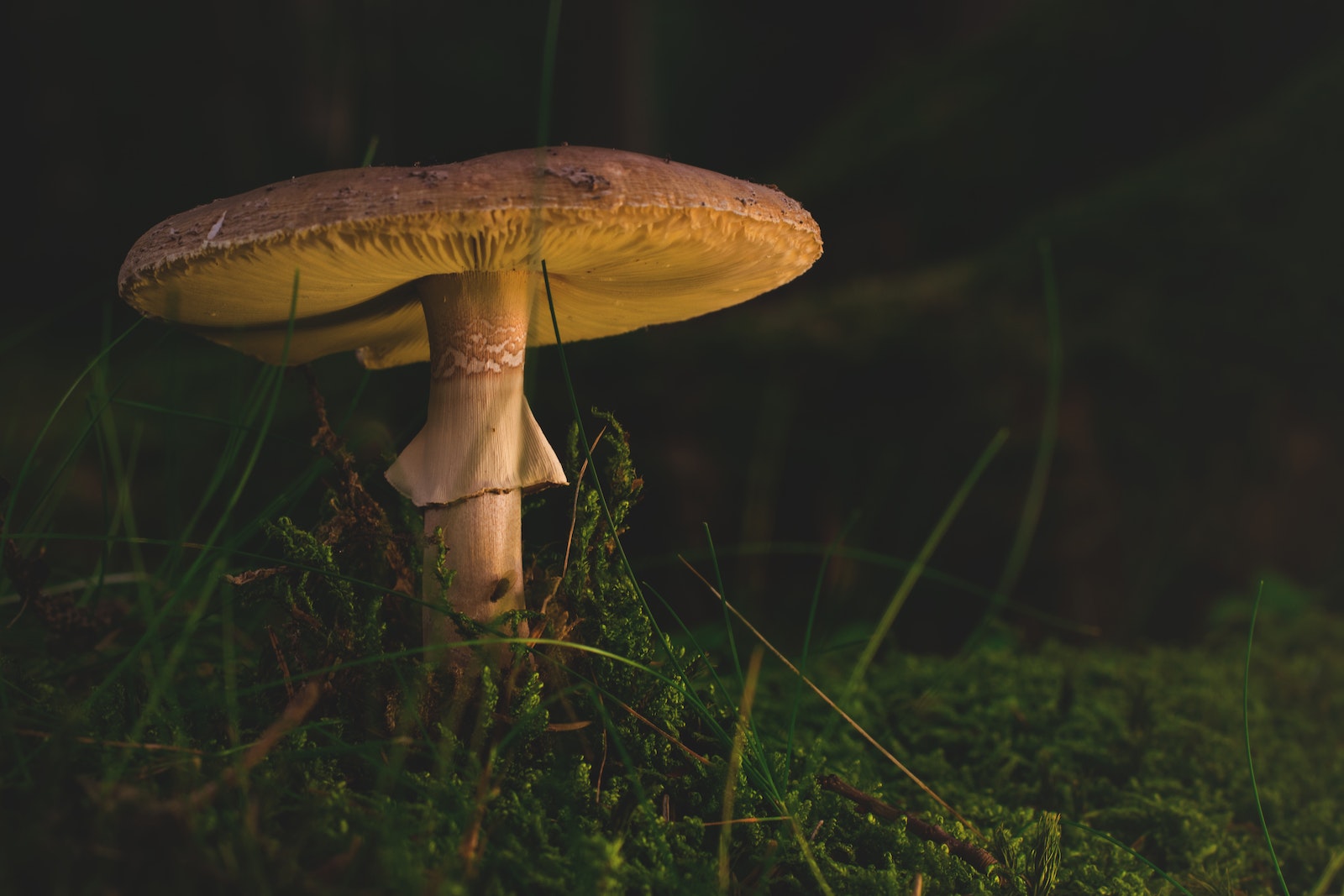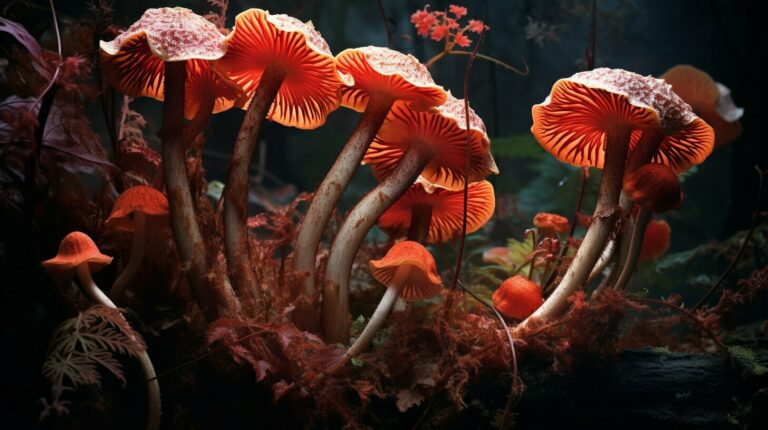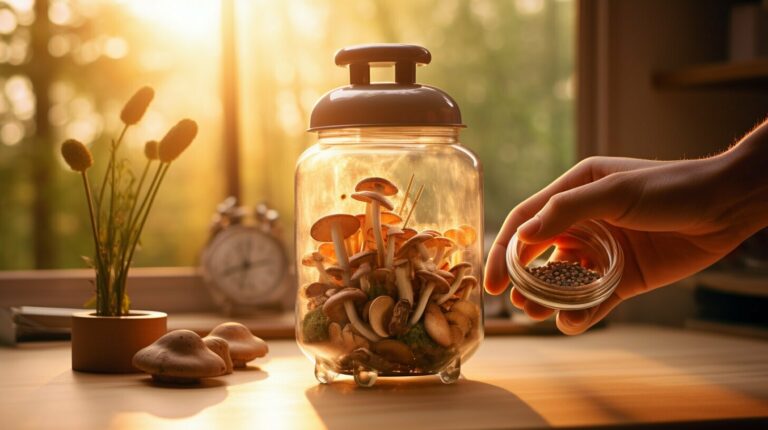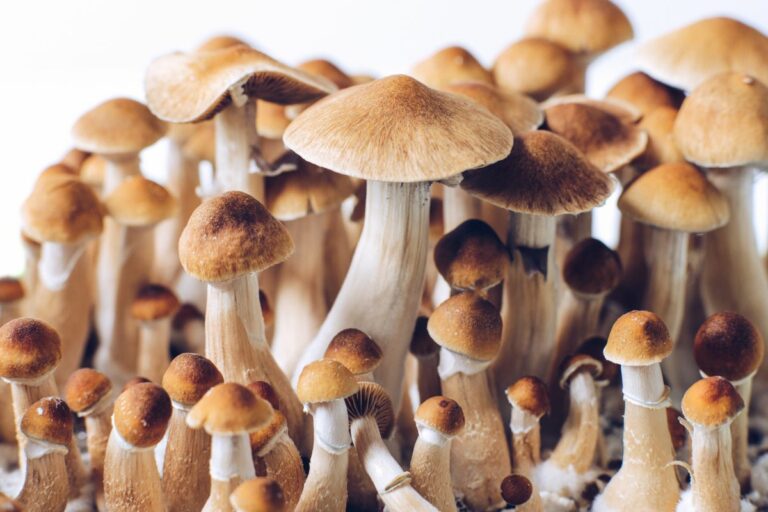Lion’s mane mushroom, scientifically known as Hericium erinaceus, is gaining popularity for its potential health benefits, unique appearance, and distinctive taste. With a flavor often compared to seafood, more specifically crab or lobster, this mushroom stands out from its counterparts. The culinary world has taken notice, and Lion’s mane has become a sought-after ingredient for a variety of dishes.
The taste of this mushroom is an essential aspect of its growing appeal. Its seafood-like flavor enhances dishes with unique taste experiences like no other mushroom. Beyond the taste, Lion’s mane also contains certain polysaccharides that support the immune, nervous, and digestive systems, making it not only a tasty addition to meals but a potentially beneficial one as well.
As interest in Lion’s mane mushroom continues to grow, chefs and home cooks alike are experimenting with incorporating its unique taste and potential health benefits into their cooking. By understanding the distinct features of this mushroom, culinary enthusiasts can unlock new possibilities and flavor combinations in their dishes.
Understanding Lion’s Mane Mushroom
Table of Contents
Lion’s Mane mushroom, scientifically known as Hericium erinaceus, is a unique edible fungus that belongs to the Hericium genus. This mushroom is characterized by its distinctive appearance, resembling a pom-pom or a cluster of icicles. It is also known by other names, such as bearded hedgehog mushroom and pom-pom mushroom. Lion’s Mane is primarily found in North America (H. americanum), Europe, and Asia.
As a type of edible gummy mushroom, Lion’s Mane is considered a culinary delicacy in many cultures. The taste of this fungus is often described as hearty with a lobster-like flavor. Its texture is tender and chewy, making it a versatile ingredient in various dishes. Lion’s Mane mushrooms can be consumed fresh or dried and are often used in soups, sauces, and stir-fries.
In addition to its culinary uses, Lion’s Mane has gained recognition for its potential health benefits. Like other medicinal mushrooms such as Reishi and Shiitake, this fungus contains bioactive compounds that may provide a range of benefits for the body and mind. Some studies have explored the chemistry, nutrition, and health-promoting properties of Lion’s Mane mushroom fruiting bodies and mycelia.
Foraging for Lion’s Mane mushrooms can be both an enjoyable outdoor activity and a sustainable way to obtain this nutritious fungus. As an edible mushroom, it is important to correctly identify Lion’s Mane mushrooms and other Hericium species to ensure safe consumption. When foraging, it is essential to be well-informed about the specific habitat, growth patterns, and distinguishing characteristics of these mushrooms, as well as the possibility of look-alikes.
In summary, Lion’s Mane mushroom is a distinctive and flavorful edible fungus with a range of culinary and potential health benefits. Its unique appearance and taste make it a sought-after ingredient for those who enjoy experimenting with different types of mushrooms in their cooking. As with any wild edible, proper identification and knowledge of the species are crucial when foraging for Lion’s Mane mushrooms.
Origin and Habitat
Lion’s mane mushroom (Hericium erinaceus) is a unique fungus known for its culinary and medicinal properties. Native to Asia, North America, and Europe, it can be found growing mainly on decaying hardwood, particularly oak trees.
This mushroom has been used in traditional Chinese medicine for centuries, known to provide numerous health benefits such as boosting immune function and supporting cognitive health. Lion’s mane mushroom is easily identifiable by its distinctive appearance, resembling a cluster of icicles or cascading white tendrils.
In its natural habitat, lion’s mane mushroom typically grows during the late summer and fall months. It prefers high humidity and a shaded environment, which is why it is commonly found in shaded areas of deciduous forests. The mushrooms can be found either at the base of trees or on the trunks of dead or dying trees.
Lion’s mane mushroom has gained popularity as a functional food in recent years, due to its unique taste and health benefits. When cooked, it has a subtle lobster or shrimp-like flavor, making it a sought-after ingredient in the culinary world. Its taste and texture have also led to its commercial cultivation, allowing for year-round availability.
Maintaining a sustainable habitat for lion’s mane mushrooms is crucial, as it plays a role in preserving this valuable fungus for future generations. Protecting natural habitats and supporting sustainable harvesting practices ensure the continued availability of lion’s mane mushrooms in both the wild and commercial markets.
Taste and Texture Comparison
Lion’s mane mushroom is a unique edible fungus with a flavor profile that sets it apart from other mushrooms. Its taste is often likened to that of seafood, especially crab and lobster, due to its delicate and succulent flavor. The mild taste of lion’s mane makes it a versatile ingredient, allowing it to blend well with various dishes while adding a touch of seafood-like flavor. Some have even referred to the taste as meaty, which further contributes to its popularity as a culinary ingredient1.
The texture of lion’s mane mushroom is another aspect that makes it so appealing. It has a meaty texture, similar to that of crab meat or even shellfish. This characteristic is particularly sought after by those looking to incorporate more plant-based options into their meals without losing the satisfying mouthfeel typically associated with animal proteins2. Its fibrous texture allows it to absorb flavors well, making it an ideal component in a wide range of dishes.
Oyster mushrooms, another popular edible mushroom variety, share some similarities in taste and texture with lion’s mane. Both are known for their subtle flavors and pleasantly chewy textures. However, lion’s mane stands out due to its more distinct seafood-like taste and its uncanny resemblance to crab and lobster in both flavor and texture3.
When comparing lion’s mane mushroom to other mushrooms, it is evident that its unique blend of taste and texture makes it a favorite among both culinary enthusiasts and those seeking healthier food options. The delicate seafood-like flavor, closely mirroring that of crab and lobster, combined with its satisfying meaty texture, sets it apart as a versatile and nutritious addition to various dishes.
Health and Medicinal Benefits
Lion’s Mane mushroom has gained popularity for its various health benefits and medicinal properties. It is particularly known for enhancing cognitive functions and promoting brain health. Research suggests that Lion’s Mane can improve memory, focus, and even sleep quality, making it a valuable functional mushroom for those seeking mental clarity and cognitive support.
One of the primary benefits of Lion’s Mane is the potential to stimulate nerve growth factor (NGF) production, a protein responsible for neuron growth and maintenance. This makes it a promising treatment option for neurodegenerative diseases, such as Alzheimer’s and dementia. Additionally, Lion’s Mane has been found to be effective in promoting nerve regeneration and reducing nerve damage, which is important for overall neurological health.
Lion’s Mane may also help alleviate mood disorders such as anxiety, depression, and stress. This is due to the presence of compounds called erinacines, which have been shown to stimulate NGF and support brain health. By improving cognitive function and promoting a healthy brain, Lion’s Mane can contribute to better emotional well-being and resilience against mental health challenges.
Another significant benefit of Lion’s Mane mushrooms is their ability to boost immune system function. They contain potent anti-inflammatory properties that can help reduce inflammation, a key factor in many chronic health conditions. Lion’s Mane also supports immune function by enhancing the activity of natural killer cells, which protect the body against infections and diseases.
Moreover, Lion’s Mane has a positive impact on gut health. It accomplishes this by promoting the growth of beneficial gut bacteria while inhibiting harmful bacteria growth. A healthy gut microbiome is linked to better brain health, as it helps to reduce inflammation and improve the overall functioning of the nervous system.
In conclusion, Lion’s Mane mushrooms offer an array of health benefits, ranging from cognitive enhancement to supporting emotional well-being and immune function. As a functional mushroom with numerous medicinal properties, incorporating Lion’s Mane into one’s diet can promote overall health and well-being.
Culinary Uses and Cooking Methods
Lion’s mane mushroom is a versatile ingredient, known for its delicious taste and tender, meat-like texture. It can be used in various recipes, from soups to side dishes, making it an excellent vegan alternative to meat-based recipes.
To begin, clean the lion’s mane mushroom by gently brushing off any dirt or debris. Avoid rinsing it under water as this can cause the delicate texture to become soggy. It is best to store fresh lion’s mane in a paper bag to maintain its freshness and quality.
Before cooking, cut the mushroom into thin slices. A popular method for preparing lion’s mane is frying it in a pan with olive oil or butter, adding salt and pepper for seasoning. For extra flavor, sauté the mushroom with minced garlic or garlic powder. This enhances its natural sweetness while maintaining a slightly crunchy texture.
Another option is to use dried lion’s mane, which can be rehydrated in warm water before adding it to recipes. Dried lion’s mane can be used in soups, sauces, or even brewed into a nutritious tea. To make the tea, steep the dried lion’s mane in hot water and strain out the solids after a few minutes. The resulting liquid can be consumed as a hot beverage or allowed to cool for use as a flavorful cooking liquid.
Lion’s mane mushroom powder is a convenient option for both cooking and supplementing your diet. The powder can be added to smoothies, mixed into sauces, or sprinkled on various dishes to enhance their nutritional value.
Multiple seasoning options complement the taste of lion’s mane mushroom. For an Asian-inspired dish, create a flavorful sauce using soy sauce, ginger, and sesame oil. If you prefer a more classic approach, a simple garlic and herb seasoning can elevate the natural flavors of the mushroom. When cooking with lion’s mane, it is crucial to remember that its delicate texture requires gentle handling and minimal cooking time.
Incorporating lion’s mane mushroom into your cooking routine can add a unique taste and texture to various dishes, while offering a variety of health benefits. With its versatile nature, the possibilities for delicious recipes are endless.
Incorporation in Daily Diets
Lion’s Mane mushrooms, known for their unique appearance and potential health benefits, can also be a tasty addition to daily diets. Their flavor is mild and versatile, making them an excellent option for various dishes. Incorporating Lion’s Mane into meals doesn’t just provide a unique taste experience, but also contributes valuable nutrients to support overall wellness.
For those who follow a vegan or plant-based lifestyle, these mushrooms can serve as a great alternative to meat or tofu due to their tender, meat-like texture. They can be used as a substitute for chicken or other protein sources in dishes like stir-fries, salads, and tacos. When cooked, Lion’s Mane mushrooms take on a succulent, savory flavor, which makes them a fantastic addition to vegetable broths and soups.
Including Lion’s Mane mushrooms in your daily diet can provide a variety of nutrients that are essential for supporting a healthy immune response and addressing other aspects of health. These mushrooms are naturally rich in potassium, an essential mineral required for the proper functioning of the heart, kidneys, and other organs. They also contain dietary fiber, which is crucial for digestive health and maintaining healthy blood sugar levels.
In order to maximize the taste and nutritional benefits of Lion’s Mane mushrooms, it is essential to cook them correctly. Cooking techniques like sautéing can help bring out their flavors while preserving their nutrients. Additionally, experimenting with different spices and seasonings can help enhance their taste and complement other ingredients in a meal.
In summary, incorporating Lion’s Mane mushrooms into daily diets can not only diversify meal options for vegans, plant-based eaters, and omnivores alike, but it also provides essential nutrients such as potassium and fiber to support overall wellbeing. By using these mushrooms in a variety of dishes and cooking techniques, individuals can enjoy the unique taste and nutritional benefits they have to offer.
Commercial Products and How to Source
Lion’s mane mushroom is not only praised for its potential health benefits but also its unique taste. Its seafood-like flavor has made it popular in various culinary dishes and commercial products. This section briefly discusses where to source Lion’s mane products and the different forms they come in, such as supplements and grow kits.
In recent years, Lion’s mane has gained popularity as a health supplement. Many health-focused stores and online retailers offer a variety of Lion’s mane supplements, ranging from capsules to powders and tinctures. These supplements are typically made from the fruiting bodies or mycelium of the mushroom, which contain the bioactive compounds associated with the mushroom’s health-promoting properties. When shopping for these supplements, it is essential to choose high-quality products from reputable brands to ensure the product’s efficacy and safety.
For those interested in incorporating fresh Lion’s mane mushrooms into their diets, sourcing may include local farmer’s markets, specialty food stores, or online distributors that sell fresh or dried mushrooms. It is important to look for Lion’s mane mushrooms that are fresh and clean, devoid of any signs of decay or contamination.
For the DIY enthusiasts and home gardeners, purchasing a Lion’s mane grow kit is an option for growing the mushrooms in a controlled environment, ensuring a steady supply of fresh fungi. Grow kits are available from several online retailers and typically include the necessary nutrients, substrate, and spores or mycelium needed for the mushrooms to grow.
In summary, Lion’s mane mushroom products can be sourced through various means – from supplements and capsules at health-focused stores to fresh or dried Lion’s mane mushrooms for culinary use at specialty food stores or online retailers, and even Lion’s mane grow kits for the avid gardeners. Whatever format one chooses, prioritizing high-quality products from reputable sources is crucial for reaping the unique taste and potential health benefits of Lion’s mane mushroom.
Post-Harvest Handling and Storage
After harvesting Lion’s Mane mushrooms, proper handling and storage are crucial to maintaining their unique taste and nutritional properties. One of the first steps to ensuring the quality of the mushrooms is to keep them clean during harvest. Avoid pulling or twisting the mushrooms and remove any debris that may be on the fruiting body.
For short-term storage, placing the mushrooms in a refrigerator can help prolong their freshness. It is recommended to store Lion’s Mane in a paper bag rather than a plastic bag, as paper bags allow for better air circulation and moisture control. This helps prevent the mushrooms from becoming slimy or moldy. The ideal temperature for refrigerated storage is between 2-4°C (35-40°F).
For longer storage periods, drying is a viable option. Drying Lion’s Mane mushrooms helps to preserve their flavor and nutritional content. To dry the mushrooms, cut them into thin slices and place them on a rack or screen in a well-ventilated area, away from direct sunlight. Depending on the humidity and temperature, it may take a few days for the mushrooms to dry completely. Alternatively, a food dehydrator can be used to expedite the process and maintain a more consistent drying environment.
Once the mushrooms are dry, they should be stored in an airtight container, away from heat, light, and moisture. This ensures that the dried Lion’s Mane mushrooms retain their taste and nutritional value for an extended period.
It’s essential to remember that while handling and storing, the conditions can impact the taste of the mushrooms. By following these storage guidelines, one can enjoy the unique taste and health benefits of Lion’s Mane mushrooms with confidence and ease.
Frequently Asked Questions
What is the flavor profile of Lion’s Mane mushroom?
The flavor profile of Lion’s Mane mushroom is unique and distinct. It has a tender, meaty texture and an earthy, slightly sweet taste with a hint of umami. The flavor is also described as nutty, making it a versatile ingredient in a variety of dishes.
Can the taste of Lion’s Mane mushroom be compared to any other foods?
Yes, the taste of Lion’s Mane mushroom can be compared to other foods. It is often said to have a flavor similar to seafood, specifically lobster or crab. This similarity in taste makes Lion’s Mane a popular choice for those looking to enjoy the taste of seafood without consuming animal products.
How does cooking Lion’s Mane mushroom affect its taste?
Cooking Lion’s Mane mushroom can accentuate its flavor and enhance its texture. When cooked, the outer layers of the mushroom become crispy, while the inside remains tender and juicy. Cooking also helps to bring out the rich, earthy flavors and natural sweetness of the mushroom.
What are some popular recipes to enhance the taste of Lion’s Mane mushroom?
Popular recipes to enhance the taste of Lion’s Mane mushroom include sautéing with garlic and butter, breading and frying as a vegetarian substitute for seafood, and incorporating it into soups, risottos, and stir-fries. Additionally, Lion’s Mane can be prepared in a simple way by grilling or roasting, allowing its natural flavors to shine.
Does the taste of Lion’s Mane mushroom change depending on its preparation?
Yes, the taste of Lion’s Mane mushroom can change depending on the preparation method. While its natural flavors are enhanced through cooking, different techniques, such as frying, grilling, or simmering, can bring out varying flavors and textures. The taste can also be influenced by the seasonings and ingredients used in a recipe.
How can the flavor of dried Lion’s Mane mushroom be improved?
To improve the flavor of dried Lion’s Mane mushroom, it is advised to rehydrate the mushrooms before cooking. Soaking them in water or broth for about 20-30 minutes can help to bring out their natural flavors while softening their texture. Additionally, using dried Lion’s Mane in recipes with ample seasoning or flavorful ingredients can help to enhance and complement their taste.
Footnotes
- https://www.researchgate.net/profile/Shujaat-Ali-4/publication/329781583_Lion’s-mane_mushroom_new_addition_to_food_and_natural_bounty_for_human_wellness_A_review/links/5c1a3e60a6fdccfc705963b8/Lions-mane-mushroom-new-addition-to-food-and-natural-bounty-for-human-wellness-A-review.pdf ↩
- https://pubs.rsc.org/en/content/articlehtml/2022/fo/d2fo00856d ↩
- https://www.mdpi.com/1420-3049/26/9/2463 ↩







